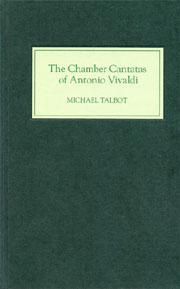Book contents
- Frontmatter
- Contents
- List of music examples
- List of tables
- Preface
- Conventions and abbreviations
- 1 The Rediscovery of Vivaldi's Cantatas
- 2 The Cantata Genre
- 3 Vivaldi and the Voice
- 4 The Mantuan Cantatas
- 5 Cantatas of the Middle Years
- 6 The Dresden Cantatas
- 7 Vivaldi's Cantatas in Perspective
- Glossary
- List of Vivaldi's cantatas published in the New Critical Edition
- Spurious works
- Bibliography
- Index to musical works
- General index
4 - The Mantuan Cantatas
Published online by Cambridge University Press: 12 September 2012
- Frontmatter
- Contents
- List of music examples
- List of tables
- Preface
- Conventions and abbreviations
- 1 The Rediscovery of Vivaldi's Cantatas
- 2 The Cantata Genre
- 3 Vivaldi and the Voice
- 4 The Mantuan Cantatas
- 5 Cantatas of the Middle Years
- 6 The Dresden Cantatas
- 7 Vivaldi's Cantatas in Perspective
- Glossary
- List of Vivaldi's cantatas published in the New Critical Edition
- Spurious works
- Bibliography
- Index to musical works
- General index
Summary
Vivaldi's Mantuan Episode
The period spanning little more than two years that Vivaldi spent at the court of the governor of Mantua, Prince Philip of Hesse-Darmstadt, is one of the most clearly defined, and most singular, of his career. His experiences in Venice, his instincts and his strategic sense must all have told him that the life of a maestro di cappella at a court would reduce his freedom of action beyond tolerable limits, yet he took the bait. The experiment was ultimately unsuccessful, even if Vivaldi was able to extricate himself neatly and remain on good terms with a patron whose name he could continue to parade on title-pages and in librettos, and who occasionally commissioned music from him. Moreover, the contact with members of the nobility of the Habsburg domains that residence in Mantua brought him proved fruitful in later years. Service at Mantua was the first stepping stone towards his meeting with Emperor Charles VI in 1728, his visit to central Europe in 1729 – and perhaps, ultimately, to his ill-fated journey to Vienna in 1740.
Ever since Vivaldi's operas made their mark on the Venetian stage in the mid-1710s, their composer became ‘hot property’. When the elector of Bavaria, Maximilian II Emanuel, newly restored to his capital city of Munich after the conclusion of the War of the Spanish Succession, asked his wife, Electress Therese Kunigunde, who had not yet returned from her exile in Venice, for advice on musicians to recruit for his Hofkapelle, she mentioned the name of Vivaldi, presumably in connection with the post of Kapellmeister.
- Type
- Chapter
- Information
- The Chamber Cantatas of Antonio Vivaldi , pp. 89 - 119Publisher: Boydell & BrewerPrint publication year: 2006



